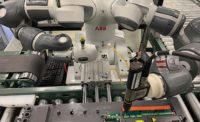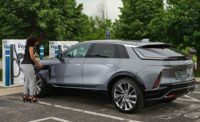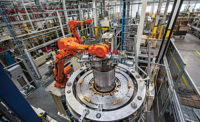This is the time of the year when millions of people roll their lawnmowers out of winter hibernation. The sound of whirring engines and the smell of fresh-cut grass are a spring ritual throughout the United States.
Many backyards and commercial landscapes are manicured with machines produced by Ariens Co. The 83-year-old, family-owned firm is a leading manufacturer of lawnmowers, snow blowers, tillers and other outdoor power equipment used by homeowners and grounds care maintenance professionals. Its products are known for their design, durability, performance and reliability.
To boost production of one of its most popular products, Ariens recently installed a new conveyor system at its flagship assembly plant in Brillion, WI. The automated guided carts (AGCs) have increased productivity and throughput by more than 60 percent.
The system features height-adjustable controls that improve employee ergonomics while maximizing operator efficiency. Riding mowers are automatically delivered to each workstation on the assembly line. Operators are no longer required to manually push the machines, which weigh up to 635 pounds, from station to station.
“We now have seven assembly stations that provide a stable and accurate production flow coupled with real-time productivity tracking,” says Jim Masters, vice president of manufacturing and engineering. “The new technology allows for increased consistency and better sequencing of our assembly operations.”
Automation allows the plant to be more flexible. Assemblers can now build some commercial and residential lawnmowers on the same line.
Machines assembled with the AGCs share the same basic frame, but many components are variable. For instance, engines, front axles, footrests, seats and tires are unique to different models.
“One of the benefits AGCs offer is ultimate flexibility,” claims Jon Hanson, director of manufacturing engineering at Ariens. “Being able to customize and quickly modify the guide path with minimal downtime adds value to the system.”
Wasted motion has also been eliminated with the automated conveyor system, which helps Ariens achieve its lean manufacturing initiatives.
“Operators are no longer required to push carts, and the cell can be paced,” says Masters, who previously worked for a Tier One supplier in the auto industry. “Work now comes directly to the station and the employee.
“The production layout has changed from a U-shaped cell to a linear assembly line,” adds Masters. “That gives operators and material handlers a lot more access to both sides. In the past, the inside of the U was causing a bottleneck, because space can get tight.”
Small Town Pride
Ariens is based in Brillion, a small town located 25 miles south of Green Bay. Its main operation is housed in a 340,000-square-foot plant that assembles a wide variety of riding mowers, stand-on mowers and walk-behind mowers. A 250,000-square-foot “sister” plant located nearby builds snow blowers.
In addition, Ariens operates a 155,000-square-foot plant in Auburn, NE, that produces edgers, trimmers, log splitters and other products. A 150,000-square-foot plant in Oxfordshire, England, assembles lawn and garden tractors that are marketed in Europe.
Although it’s not a large company, Ariens shares something in common with well-known firms such as Apple, Disney, Hewlett-Packard and Mattel. All those companies were started in garages.
Ariens traces its roots to 1933. That’s when Henry Ariens developed the first American-made rotary tiller. He then started building the device in his garage in Brillion.
The Model A tiller was powered by an air-cooled engine and was marketed to commercial vegetable growers and nurseries. Ariens eventually created a full line of tillers that eliminated the need for hand spading and ensured better soil conditions.
After World War II, the company developed a multi-row Tillivator for farmers. The tractor-mounted unit could cultivate four to 16 rows at a time.
In the early 1950s, Ariens introduced products aimed at homeowners who were enjoying the booming post-war economy. One machine included a rotary tiller, a sickle bar and a 25-inch lawn mower. Another device featured an attachment for throwing snow.
In 1958, the company unveiled a line of riding mowers. Two years later, Ariens developed a two-stage snow removal machine called the Sno-Thro. Fewer than 1,000 units were produced in 1960, but by the end of the next decade, the company was assembling 100,000 machines annually. The company also made snowmobiles for several years.
During the 1970s and 1980s, Ariens experienced tremendous growth due to the introduction of new lawn and garden equipment products, facility expansions and strategic acquisitions. One of its most important purchases was Gravely Co., an outdoor power equipment manufacturer founded in 1916.
Today, the privately held company is run by Dan Ariens. The fourth-generation family member took over the reins from his father (grandson of the company founder) in 1998.
Under his leadership, the company has completed several key acquisitions. It has also achieved continuous improvement in its operations by adhering to lean manufacturing principles.
More than a decade ago, Ariens created a lean culture that has permeated its world-class manufacturing facilities. The company conducted its first kaizen event in 2000 and hasn’t stopped focusing on waste elimination. In fact, Ariens directly attributes its ability to remain solvent in the increasingly competitive outdoor power equipment industry to the contributions of employees using lean practices.
“Our lean initiative is focused on the endless pursuit of the elimination of waste,” explains Masters. “A few years ago, when we noticed that a significant portion of our operators’ time was spent on positioning fixtures and moving carts between workstations, we decided to investigate automation.
“The old production method was not adding value to the product,” says Masters. “So, we addressed the issue by taking advantage of a proven technology.”
Diverse Products
Ariens’ product portfolio includes some of the oldest and most respected names in the outdoor power equipment industry, such as Countax, Gravely, Sno-Tek and Westwood. And, the company makes products under the Ariens label.
It builds a wide variety of commercial outdoor power equipment, such as ride-on mowers, stand-on mowers, wide-area walk behind mowers, edgers, log splitters and power brushes. Customers include homeowners, commercial landscapers and facilities maintenance professionals.
In addition to lawn care products, Ariens is America’s leading producer of snow removal equipment. In fact, the company touts itself as "The King of Snow” and is the official snow blower of Lambeau Field, the home of the Green Bay Packers.
Ariens produces 20 different snow blower models. The products range from single-stage machines that weigh 107 pounds and clear 21-inch wide paths to professional two-stage units that weigh 396 pounds and clear 36-inch wide paths.
Ariens sells its products through a mix of independent dealers; retailer-owned hardware cooperatives, such as True Value; and big-box stores such as Home Depot. The company’s two main brands are Ariens and Gravely.
Ariens-branded products are targeted at homeowners and are painted orange. Gravely is a 100-year-old, dealer-exclusive brand with bright red-colored machines. The dealer network provides the sales and service support required by commercial landscape contractors, government purchasers and sports field maintenance personnel.
Ariens produces 61 unique models of riding mowers and more than 13 distinct platforms. But, it specializes in zero-turn mowers.
Zero-turn machines offer numerous benefits to homeowners and professional landscape contractors. For instance, the mower can turn within its own footprint. And, the mowing deck contains three spindles that turn cutting blades.
The main difference between a zero-turn mower and a lawn tractor equipped with a traditional steering wheel is in the controls. Each rear wheel has an independent transmission (one on the right and one on the left) that is controlled by two steering handles.
The independent steering controls provide extreme maneuverability. If you push the right steering handle forward, the right wheel moves forward; pulling the handle back makes the machine go in reverse.
Zero-turn mowers cut grass nearly twice as fast as traditional garden tractors. A typical tractor cuts at a speed of 3 to 4 mph vs. 5 to 8 mph for a zero-turn mower. That’s why the machines are extremely popular with landscape professionals.
Consumer products typically range in price from $2,500 to $5,000. However, commercial machines can cost anywhere from $3,000 to $23,000, depending on options such as extra-powerful engines, robust transmissions and wide cutting decks. A variety of gasoline, diesel, natural gas and propane-powered engines are available to meet different needs.
Ariens produces four lines of riding mowers in the Brillion factory: IKON X, IKON XL, MAX ZOOM and ZOOM. Gravely products assembled there include the Compact-Pro, Pro-Master and Pro-Turn.
Last August, Ariens installed an automated guided cart system to assemble the Ariens IKON X and the Gravely ZT X, which are two of its most popular products.
High-Mix Assembly
Ariens operates eight high-mix assembly lines at its lawnmower factory. Each of the lines is dedicated to a different family of products. Because of the seasonal nature of the products, peak production occurs from January to May.
“Some cells can be reconfigured quickly to build other models and some are dedicated lines due to consistent annual volume and demand,” says Masters. “We use a 12-month rolling build plan that’s based on received orders, received customer forecasts and historical data.”
Riding mowers built on the new automated assembly line are produced in multiple configurations to meet different customer needs. For instance, the IKON X Series, which is popular with homeowners, features two product families and 19 stock keeping units.
Customers can choose either a 22- or 24-hp engine produced by Briggs & Stratton or Kohler (commercial machines built on the assembly line also use Kawasaki engines). The machines are available with either a 42-inch or a 52-inch cutting deck. The Ariens IKON X and the Gravely ZT X share the same tubular steel frame, in addition to some basic parts.
Ariens purchases components such as bearings, controls, cutting blades, engines, fenders, front axles, seats, tires and transmissions. But, the company operates a large in-house metal fabrication operation that cuts, stamps and welds frames, mowing decks, spindles and other aluminum and steel components.
Manual and robotic arc welding equipment is used to join the components. For instance, tubular frames are welded as a single-piece construction to ensure durability.
Being vertically integrated ensures quality and allows Ariens to quickly respond to market demand fluctuations.
“Mowing decks are very specific to the machines that we produce,” says Masters. “They are directly responsible for the longevity and performance of our products.
“We hold decks very close to our heart and put many hours into R&D efforts,” adds Masters. “There’s no such thing as standard grass. Many different factors influence performance, including temperature, humidity, and the length and thickness of grass blades.
“We also have a very talented in-house tooling group that makes all of our dies, assembly fixtures and welding fixtures,” Masters points out.
Subassembly lines build components such as control arms and transmissions, and feed them to the main assembly line. Because most joining tasks involve screwdriving, assemblers use a variety of cordless, DC electric and pneumatic tools.
Material handlers pick parts in a supermarket, then supply them in kits to the assembly line. Each kit contains enough parts to build at least three machines at a time. The kits are delivered to workstations as the AGCs index forward.
Automation Advantages
Before investing in automated guided cart technology, Ariens considered other types of conveyors, including traditional fixed systems.
“We ruled them out, because we wanted to allow operators to position the work where they wanted it,” says Masters. “We didn’t want to mandate where it should be.”
According to Masters, AGCs offered numerous advantages. For instance, they are smaller, cheaper and easier to install than traditional automated guided vehicles. The devices also improve plant floor efficiency, reduce operating costs and provide more flexibility over other types of conveyor systems.
They are designed for applications where lighter loads and flexibility are required. The carts are guided by floor-mounted magnetic tape that can be easily reconfigured on an assembly line in response to product or volume changes.
The AGC system at Ariens currently uses eight carriers attached to tunnel-type tuggers that stop at seven workstations laid out in a straight line. They replaced a manual, U-shaped cell in which assemblers pushed carts from workstation to workstation. However, that type of assembly system is still used in other parts of the plant.
Ariens engineers designed and built the height-adjustable steel carriers in-house. They feature casters, adjustable clamps and rotatable fixtures that fit over tuggers supplied by Wisconsin Lift Truck Corp. (a local systems integrator for Jervis B. Webb Co., a subsidiary of Daifuku North America).
“The height-adjustable, rotational features provide easier accessibility,” says Masters. “In the past, operators had to stretch, bend and lean in to attach some components under the frame. Assemblers now have full access to it. When necessary they just roll the entire frame over or onto its side. Instead of people working around the work, the work now works around them.”
Another key feature of the automated line is visual work instructions that are issued by Ariens’ engineering center. They’re created by the same people who write owners’ manuals, parts lists and service manuals.
Work instructions are automatically updated every day. A wireless network on the plant floor looks for updates and changes every 15 seconds.
“Whenever something changes, the screen at the workstation that’s affected turns red to alert assemblers,” says Masters. “Operators then must acknowledge it.”
The screens are intelligent and know what’s coming down the line. For instance, if an Ariens-branded machine appears after a Gravely model, the screen automatically changes. The real-time system also features three languages—English, Spanish and Somali—to meet the needs of the company’s diverse workforce.
Ariens is currently in the process of installing AGCs at its snow blower assembly plant. When the system ramps up later this year, it will feature 58 workstations and will run at a faster speed than the riding mower line.
“The line we put in last year produces a mower every five minutes,” says Masters. “The snow blower line will produce a new product every 45 seconds. Our old production process, with manually pushed carts, was 190 seconds.”
Many of the engines used in riding mowers produced at the Ariens factory in Brillion, WI, are built 40 miles away. Click here to learn how Kohler Co. assembles small gas engines.

















